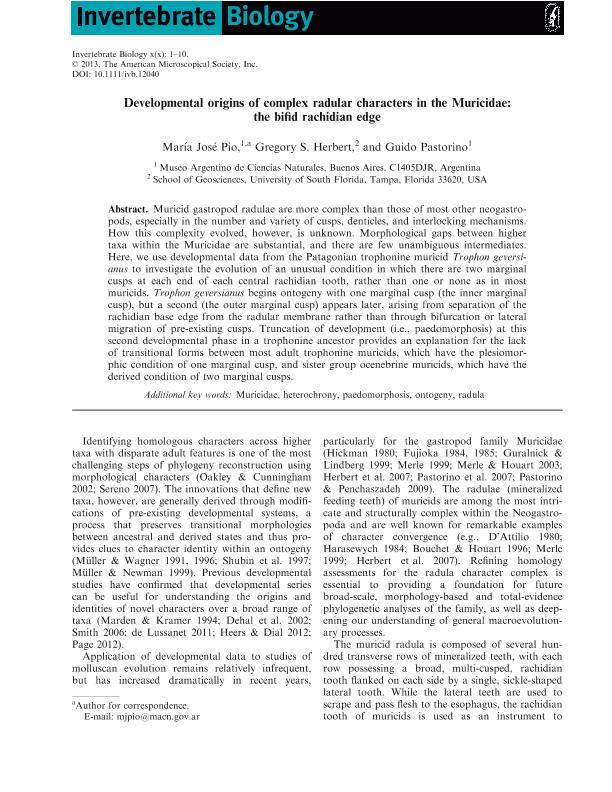Mostrar el registro sencillo del ítem
dc.contributor.author
Pío, María José

dc.contributor.author
Herbert, Gregory S.
dc.contributor.author
Pastorino, Roberto Santiago Guido

dc.date.available
2017-12-04T20:28:10Z
dc.date.issued
2013-12
dc.identifier.citation
Pío, María José; Herbert, Gregory S.; Pastorino, Roberto Santiago Guido; Developmental origins of complex radular characters in the Muricidae: the bifid rachidian edge; Wiley; Invertebrate Biology; 133; 1; 12-2013; 64-73
dc.identifier.issn
1077-8306
dc.identifier.uri
http://hdl.handle.net/11336/29643
dc.description.abstract
Muricid gastropod radulae are more complex than those of most other neogastropods, especially in the number and variety of cusps, denticles, and interlocking mechanisms. How this complexity evolved, however, is unknown. Morphological gaps between higher taxa within the Muricidae are substantial, and there are few unambiguous intermediates. Here, we use developmental data from the Patagonian trophonine muricid Trophon geversianus to investigate the evolution of an unusual condition in which there are two marginal cusps at each end of each central rachidian tooth, rather than one or none as in most muricids. Trophon geversianus begins ontogeny with one marginal cusp (the inner marginal cusp), but a second (the outer marginal cusp) appears later, arising from separation of the rachidian base edge from the radular membrane rather than through bifurcation or lateral migration of pre-existing cusps. Truncation of development (i.e., paedomorphosis) at this second developmental phase in a trophonine ancestor provides an explanation for the lack of transitional forms between most adult trophonine muricids, which have the plesiomorphic condition of one marginal cusp, and sister group ocenebrine muricids, which have the derived condition of two marginal cusps.
dc.format
application/pdf
dc.language.iso
eng
dc.publisher
Wiley

dc.rights
info:eu-repo/semantics/openAccess
dc.rights.uri
https://creativecommons.org/licenses/by-nc-sa/2.5/ar/
dc.subject
Muricidae
dc.subject
Heterochrony
dc.subject
Paedomorphosis
dc.subject
Radula
dc.subject.classification
Otras Ciencias Biológicas

dc.subject.classification
Ciencias Biológicas

dc.subject.classification
CIENCIAS NATURALES Y EXACTAS

dc.title
Developmental origins of complex radular characters in the Muricidae: the bifid rachidian edge
dc.type
info:eu-repo/semantics/article
dc.type
info:ar-repo/semantics/artículo
dc.type
info:eu-repo/semantics/publishedVersion
dc.date.updated
2017-12-04T20:04:50Z
dc.journal.volume
133
dc.journal.number
1
dc.journal.pagination
64-73
dc.journal.pais
Estados Unidos

dc.journal.ciudad
Hoboken
dc.description.fil
Fil: Pío, María José. Consejo Nacional de Investigaciones Científicas y Técnicas. Oficina de Coordinación Administrativa Parque Centenario. Museo Argentino de Ciencias Naturales "Bernardino Rivadavia"; Argentina
dc.description.fil
Fil: Herbert, Gregory S.. University of South Florida; Estados Unidos
dc.description.fil
Fil: Pastorino, Roberto Santiago Guido. Consejo Nacional de Investigaciones Científicas y Técnicas. Oficina de Coordinación Administrativa Parque Centenario. Museo Argentino de Ciencias Naturales "Bernardino Rivadavia"; Argentina
dc.journal.title
Invertebrate Biology

dc.relation.alternativeid
info:eu-repo/semantics/altIdentifier/doi/http://dx.doi.org/10.1111/ivb.12040
dc.relation.alternativeid
info:eu-repo/semantics/altIdentifier/url/http://onlinelibrary.wiley.com/doi/10.1111/ivb.12040/abstract
Archivos asociados
